The two main components of the working area in the kitchen are a stove (hob) and a sink. The sink is designed to wash vegetables, fruits, dishes, hands. She is considered an indispensable assistant to the hostess. When choosing kitchen sinks, it is important to choose a reliable and practical product that will fit into the interior of the room and will successfully harmonize with furniture and household appliances. Recently, the most popular are metal models. Consider what options manufacturers offer, how to choose the best sink, and also talk about the rules for caring for a metal sink.

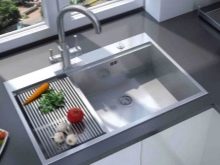
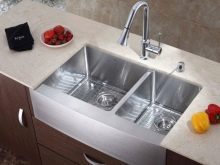
Varieties
A metal sink for the kitchen can be made of several materials. The most popular models are those made of stainless steel, consisting of chromium and nickel. The surface of steel sinks can be polished or matte, less often there are products with a surface that visually resembles a linen cloth. Some companies offer stainless steel sinks coated with brass, bronze or gold.
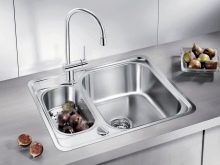
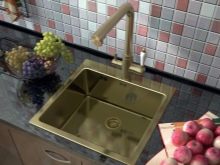

Iron shells are less common on sale. To increase reliability and durability, the products are coated with zinc. Galvanized sinks are not subject to corrosion, they look stylish and can be combined with a kitchen set of any materials.
Another unpopular option include kitchen sinks made of non-ferrous metals. They can be made of brass, copper or aluminum.
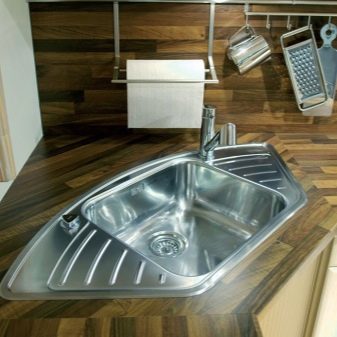
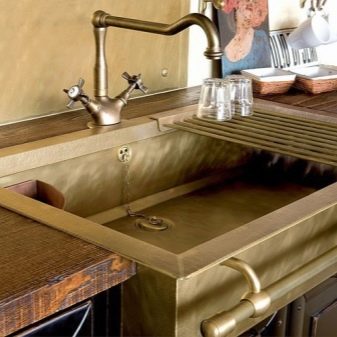
Aluminum sinks, like copper ones, are characterized by increased softness. Due to this feature, scuffs and scratches will form on their surface under the slightest mechanical stress and power loads. The rarest are considered models of sinks made of cast iron or enameled black steel. Cast iron products are weighty, because of which it is difficult to install and dismantle, and steel models coated with white enamel have an unpresentable appearance.
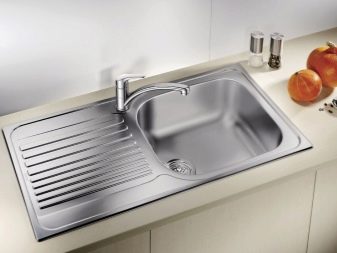
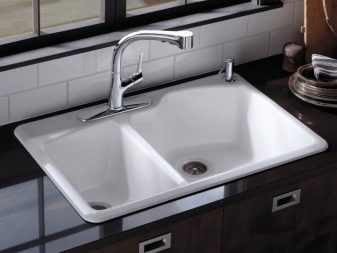
Advantages and disadvantages
Especially popular among consumers are metal kitchen sinks made of stainless steel. Consider their pros and cons. The advantages include affordable cost and a large assortment - you can choose products with different surface textures, with various shapes and sizes. Among the pluses are also noted:
- flexibility and durability - unlike ceramic products, metal ones in case of accidental falling of dishes or other objects will not break, and when deformed, they are easily straightened;
- corrosion resistance - sinks are made of a specialized alloy that is not afraid of prolonged contact with water;
- ease of installation - you can install a new sink yourself, without the involvement of hired specialists;
- aesthetics - metal products have a presentable appearance, so they fit into any kitchen interior;
- resistance to high temperatures - in contact with hot dishes, the product will not lose its aesthetics;
- easy maintenance - it is easy to remove all types of contaminants from a steel surface with any detergent and cleaning agent at hand.


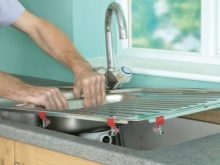
Metal sinks have some drawbacks. Their main disadvantage is “noise”. Budget models made of thin metal and not having specialized noise insulation layers make sounds when the water flows from the tap and in contact with dishes. Sometimes such noises are heard even in neighboring apartments. When used on the surface of the product, scratches and abrasions are formed.
Such defects appear even with careful handling of the product. Scratches do not affect the performance of the sink, but they can greatly ruin its aesthetics.
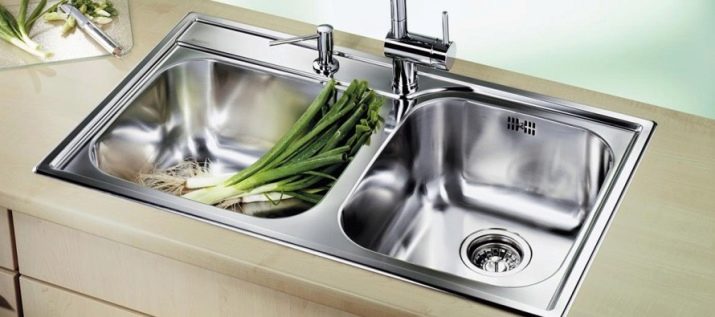
Model Overview
Aluminum, galvanized, iron sinks and stainless steel products are available in an extensive range. Products are welded and stamped. The first have a connecting seam located between the bowl and the plane of the bowl. The latter do not have welded joints. Models are:
- mortise - mounted in the plane of the surface;
- built-in - are fixed at the level of the working surface of the countertop;
- consignment notes - are installed in a separate curbstone with the corresponding dimensions.
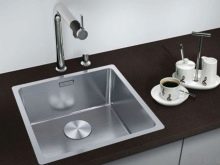
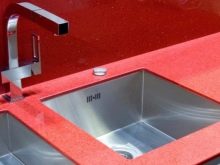
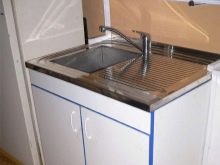
Kitchen sinks can have 1-2 identical or different sized bowls. There are models with three bowls. Thanks to the large selection, you can choose a model for any type and size of kitchen. Metal sinks have a different configuration. Depending on the needs and personal preferences, you can choose a product of round, oval, square, rectangular or trapezoidal shape.
Sinks can be equipped with different sizes of sides, providing practicality and ease of use. Also on sale are models with “wings” - this is a horizontal surface that is placed on one or both sides of the sink.
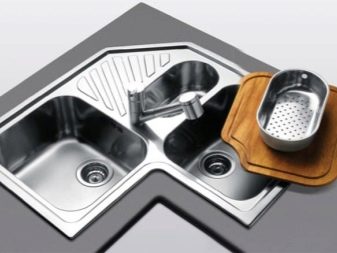
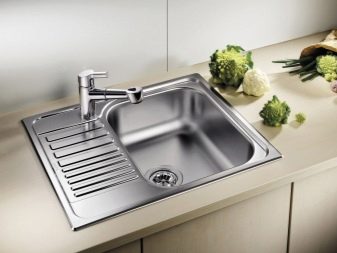
Criterias of choice
There are a lot of models of metal sinks for the kitchen, which makes it sometimes difficult to make the right choice. The tips below will help you make a successful purchase.
- The quality of steel. High-quality products must contain at least 18% chromium and 10 nickel (designation 10/18). Items made of such an alloy have good anti-corrosion properties, corrosion resistance and high temperature resistance.
- The thickness of the metal. The higher the rate, the better.Too thin products (0.4 mm) produce loud noises when the pressure of water from the tap is high, and besides, they are easily deformed under power loads (for example, if you put heavy dishes in the bowl). Good quality products must have a thickness of at least 0.6 mm.
- Bowl depth. The higher this indicator, the more convenient it will be to use the sink - it will be possible to soak a lot of dirty kitchen utensils in it. The average depths range from 15 to 18 cm.
- Type of surface. Sinks are smooth or textured. Matte products retain external impeccability longer during intensive use, while glossy products are considered less “capricious" in care. Drops from water, stains and various contaminants will be very noticeable on a glossy surface. Textured products in this regard are more practical.
Consumers have the opportunity to purchase sinks with additional accessories. These include removable containers with holes, boards with grooves, dryers. Basically, these accessories are attached to most expensive models.
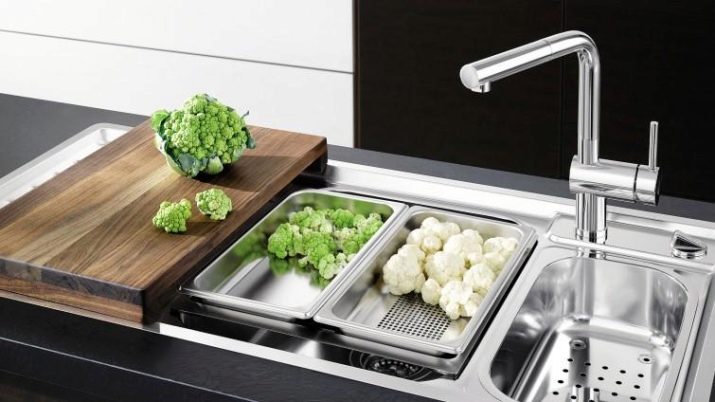
Care Rules
Metal washers are considered picky to care for. However, there are some rules, compliance with which will allow for a long time to preserve the aesthetics of products. The sink should be washed after each use. If you ignore this advice, an oxide layer forms on the surface over time, due to which the product will lose its luster.
Once a week, the sink must be washed with specialized products designed to care for metal objects. As a rule, these are various gels. Using cleaning products that contain abrasive particles is undesirable. Abrasives can scratch and scuff. For the same reasons, you should refuse to use a metal sponge and a stiff brush.
If the sink is too dirty, it is necessary to pour water into it and add vinegar. In the "soaked" state, the sink should stand for at least 1-2 hours. After that, wash the surface with detergent.
Compliance with these rules is a guarantee of maintaining external impeccability and long service of a metal kitchen sink.
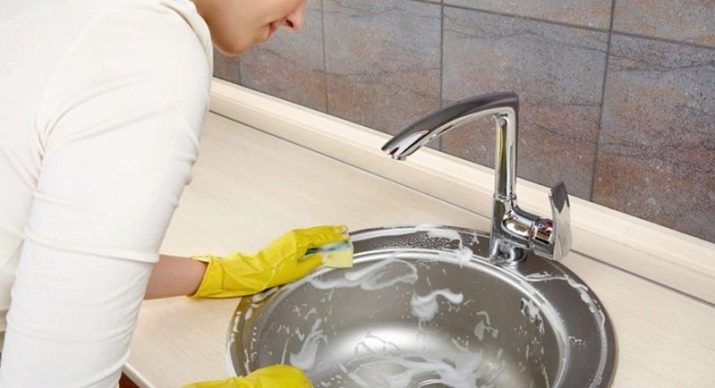
On how to choose a sink for the kitchen, see the next video.









